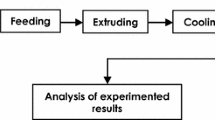Abstract
Taguchi’s design of experiment and numerical simulation were applied in the optimization of an aluminum profile extrusion process. By means of HyperXtrude, the extrusion process was simulated and the effects of process parameters on the uniformity of metal flow and on the extrusion force were investigated with the signal to noise ratio and the analysis of variance. Through analysis, the optimum combination of process parameters for uniform flow velocity distribution was obtained, with the billet diameter of 170 mm, ram speed of 2.2 mm/s, die temperature of 465°C, billet preheated temperature of 480°C, and container temperature of 425°C. Compared with the initial process parameters, the velocity relative difference in the cross-section of extrudate was decreased from 2.81% to 1.39%. In the same way, the optimum process parameters for minimum required extrusion force were gained, with the billet diameter of 165 mm, ram speed of 0.4 mm/s, die temperature of 475°C, billet preheated temperature of 495°C, and container temperature of 445°C. A 24.7% decrease of required extrusion force with optimum process parameters was realized. Through the optimization analysis in this study, the extrusion performance has been greatly improved. Finally, the numerical results were validated by practical experiments, and the comparison showed that the optimization strategy developed in this work could provide the effective guidance for practical production.
Similar content being viewed by others
References
Karayel D (2008) Simulation of direct extrusion process and optimal design of technological parameters using FEM and artificial neural network. Key Eng Mater 367:185–192
Hans Raj K, Swarup Sharma R, Srivastava S, Patvardhan C (2000) Modeling of manufacturing processes with ANNs for intelligent manufacturing. Int J Mach Tools Manuf 40:851–868
Abrinia K, Makaremi M (2009) An analytical solution for the spread extrusion of shaped sections. Int J Adv Manuf Technol 41:670–676
Mihelic A, Stok B (1998) Tool design optimization in extrusion processes. Comput Struct 68:283–293
Ulysse P (1999) Optimal extrusion die design to achieve flow balance. Int J Mach Tools Manuf 39:1047–1064
Zou L, Xia JC, Wang XY, Hu GA (2003) Optimization of die profile for improving die life in the hot extrusion process. J Mater Process Technol 142:659–664
Byon SM, Hwang SM (2003) Die shape optimal design in cold and hot extrusion. J Mater Process Technol 138:316–324
Jurkovic Z, Jurkovic M, Buljan S (2006) Optimization of extrusion force prediction model using different techniques. J Achieve Mater Manuf Eng 17:353–356
Chen ZZ, Lou ZL, Ruan XY (2007) Finite volume simulation and mould optimization of aluminum profile extrusion. J Mater Process Technol 190:382–386
Lucignano C, Montanari R, Tagliaferri V, Ucciardello N (2010) Artificial neural networks to optimize the extrusion of an aluminium alloy. J Intell Manuf 21:569–574
Taguchi G (1987) The system of experimental design: engineering methods to optimize quality and minimize costs. Quality Resources, White Plains, NY
Fareghi Alamdari R, Hajimirsadeghi SS, Kohsari I (2010) Synthesis of silver chromate nanoparticles: parameter optimization using Taguchi design. Inorg Mater 46:60–64
Kraft FR, Gunasekera S (2005) Conventional hot extrusion. In: Semiatin SL (ed) ASM handbook, volume 14A: metalworking: bulk forming, vol 14. ASM International, Materials Park, Ohio, pp 421–439
Bauser M, Sauer G, Siegert K (2006) Extrusion, 2nd edn. ASM International, Ohio
Lin JL, Wang KS, Yan BH, Tarng YS (2000) Optimization of the electrical discharge machining process based on the Taguchi method with fuzzy logics. J Mater Process Technol 102:48–55
Lin YC, Chen YF, Wang DA, Lee HS (2009) Optimization of machining parameters in magnetic force assisted EDM based on Taguchi method. J Mater Process Technol 209:3374–3383
Tortum A, Yayla N, Celik C, Gokdag M (2007) The investigation of model selection criteria in artificial neural networks by the Taguchi method. Physica A 386:446–468
HyperXtrude 10.0 manual, Altair Engineering, Inc. http://www.tx.altair.com.
Sahoo AK, Rout AK (2009) Investigation of optimal parametric combination for minimum cutting force in turning: response surface methodology approach. J Eng Innovation Res 1:6–13
Adnani A, Basri M, Malek E, Salleh A, Rahman M, Chaibakhsh N, Rahman R (2010) Optimization of lipase-catalyzed synthesis of xylitol ester by Taguchi robust design method. Ind Crop Prod 31:350–356
Acknowledgments
The authors would like to acknowledge financial support from National Natural Science Foundation of China (51105230) and China Postdoctoral Science Foundation funded project (20100481247), 201104586), Shandong Provincial Natural Science Foundation (Z2008F09), State Key Laboratory of Materials Processing and Die & Mould Technology (2011-P09), Program for Changjiang Scholars and Innovative Research Team in University of Ministry of Education of China (IRT0931) and National Science & Technology Pillar Program in the Eleventh Five-year Plan Period of the People’s Republic of China (2009BAG12A07-B01).
Author information
Authors and Affiliations
Corresponding authors
Rights and permissions
About this article
Cite this article
Zhang, C., Zhao, G., Chen, H. et al. Optimization of an aluminum profile extrusion process based on Taguchi’s method with S/N analysis. Int J Adv Manuf Technol 60, 589–599 (2012). https://doi.org/10.1007/s00170-011-3622-x
Received:
Accepted:
Published:
Issue Date:
DOI: https://doi.org/10.1007/s00170-011-3622-x




